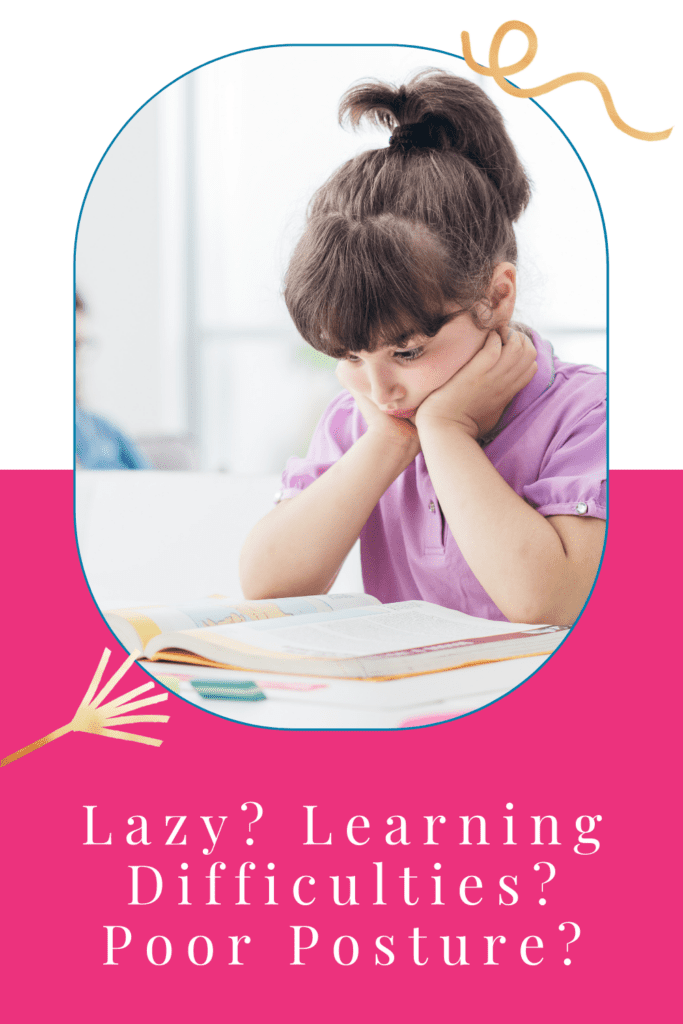When Brian and Kim met me about their son Josh they had very different opinions about why Josh was struggling in school. Brian thought his son was just lazy. The teachers did too.
Mom knew Josh was trying his best and that he didn’t want to be what Josh called ‘the dumb kid’. But all that Dad and his teachers saw was Josh slumped over his work, or laying down to do his school work.
“He doesn’t pay attention. That’s why he doesn’t remember anything. How can you concentrate when you lay down to do your work?” Josh’s dad asked rhetorically.
How the Tonic Labyrinthine Reflex Can Cause Multiple Learning Difficulties
When kids have difficulties like Josh with learning, reading and writing and their parents or teachers think they are lazy, I often suspect a retained Tonic Labyrinthine Reflex (TLR).
Bonnie Brandes in Symphony of Reflexes states that a retained TLR will have major impacts on a child’s learning ability. “Retention of the TLR indicates developmental delays or neurological abnormalities and may cause a multitude of complications.”
TLR, Auditory Processing, Balance & Global Learning Challenges
A retained TLR has such a significant impact on learning because it is connected to the development of the vestibular system. The vestibular system is the CEO of learning; it connects to all other senses and activates the whole nervous system to operate correctly via messages it sends to the higher brain levels.
Because the TLR involves the development of the vestibular system and inner ear, it often affects auditory processing – which will affect overall learning ability. Following instructions, processing information, reading ability and memory can all be impacted when this reflex doesn’t disappear during infancy.
TLR’s Connection to Academic Performance
The TLR reflex is a child’s first response to gravity and helps a newborn baby straighten out from a curled position. It is the foundation of head control. This reflex is all about balance which is associated with the development of the vestibular system (think balance in the inner ear).
As a child gains control of their head and engages in tummy time this assists with the development of their upper body strength as well as the muscles in the neck, shoulders, and back.
This reflex should integrate at around 2-4 months. TLR integration helps with creating connections in the temporal lobe of the brain which is connected to the ability to sequence.
This is necessary to follow a series of instructions correctly, to read and write letters or words in order, to accurately retell the events of a story, as well as with math in order to follow a formula, tell time and make calculations – and even for effective coordination and overall body movement.
The TLR Assists with Preparing the Body for Crawling
I have talked before about the importance of crawling for brain development. The TLR helps with developing muscle strength particularly in the upper body and arms as a child pulls themselves across the floor.
This is necessary to integrate the ATNR so the child can start doing the army crawl (sometimes referred to as creeping) which requires good muscle development in the arms.
If the TLR does not integrate, when a child turns their head, the muscle tone changes and this will impact balance. A child’s development of creeping and crawling will be affected because when he bends his head back the legs straighten out making it difficult to crawl which can then lead to the STNR reflex being retained as well.
How a Retained TLR Affects Vision
Since balance and vision are connected when the TLR is retained it gives incorrect messages between the brain and the receptors that are responsible for knowing where the body is in relation to space which also impact the function of the eyes.
This is because balance and vision are part of the same loop. Information is passed back and forth between the eyes and the brain regarding the head’s position and the body’s location in space.
The body can make adjustments accordingly so that the eyes stabilize. When this reflex is retained a child may have eye movement difficulties and poor visual perception (trouble with space, distance and depth perception).
The Impact on Coordination, Movement and Posture
A retained TLR will not only affect reading, writing and even math but whole body movements. It’s not uncommon for kids with dyspraxia to have a retained TLR.
These kids are sometimes considered lazy because when the TLR is retained posture will be affected. A child may appear to be lazy because they have difficulty sitting up straight.
The reflex naturally causes them to hunch over or to lay back. Sitting up straight is uncomfortable, tiring and compromises concentration levels.
Signs of a Retained TLR:
- Poor balance and posture
- Learning difficulties
- Poor auditory processing (trouble following multiple instructions)
- Walks on toes, right muscles in certain areas
- Low muscle tone
- Did not crawl or had an atypical crawl
- Laborious reading, poor reading comprehension
- Speech difficulties
- Poor sequencing
- Says ‘huh?’ or ‘what?’ a lot
- Poor sense of direction
- Difficulties with reading and writing
- Tires easily with writing
- Motion sickness
- Easily fatigued, perceived as lazy
- Poor sense of timing & rhythm
- Overly flexible joints
- Dyspraxia
- Disorganized
- Poor visual perception (ie. May not see spaces between letters or words)
- Difficulty paying attention when head is down
Test for a Retained TLR
Have your child stand with their feet together and arms at their side. If possible have them close their eyes. Gently and slowly move their head up and hold for 5-7 seconds. Then move their head downwards for 5-7 seconds.
As your child’s head moves up and down, you want to watch if your child:
- Loses balance
- Sways
- Locks knees
- Holds their breath
- Changes muscle tone
- Becomes dizzy or nauseous
If your child has a retained TLR, they will need targeted exercises to integrate that reflex to help improve their ability to read and write optimally and to improve general learning ability and focus.
Keep in mind that addressing learning and behaviour difficulties is not usually as simple as integrating one reflex. These kids often have numerous retained reflexes and other factors need to be considered as well when it comes to brain organization such as poor vestibular function as well as a brain hemisphere that may be underdeveloped.
To learn more about how to improve your child’s learning, reading and behaviour so they can regain their confidence and reach their full potential, book a free Clarity Call to find out if my 6-month program the Full Potential Formula is right for your child.
Sources:
Brandie Blondes – Symphony of Reflexes
Harald Bomberg M.D. – The Rhythmic Movement Method
Sally Goddard Blythe – Attention, Balance and Coordination


